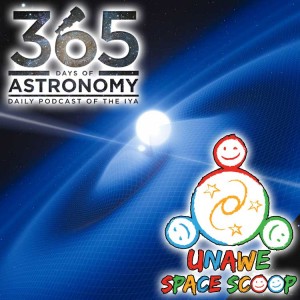Podcaster: Richard Drumm
 Title: Space Scoop: The Disappearance of the Cosmic Spinning Top
Title: Space Scoop: The Disappearance of the Cosmic Spinning Top
Organization: Astrosphere New Media
Link : astrosphere.org ; http://unawe.org/kids/unawe1501/
Description: Space scoop, news for children.
Bio: Richard Drumm is President of the Charlottesville Astronomical Society and President of 3D – Drumm Digital Design, a video production company with clients such as Kodak, Xerox and GlaxoSmithKline Pharmaceuticals. He was an observer with the UVa Parallax Program at McCormick Observatory in 1981 & 1982. He has found that his greatest passion in life is public outreach astronomy and he pursues it at every opportunity.
Today’s sponsor: This episode of “365 Days of Astronomy” is sponsored by — no one. We still need sponsors for many days in 2015, so please consider sponsoring a day or two. Just click on the “Donate” button on the lower left side of this webpage, or contact us at signup@365daysofastronomy.org.
Transcript:
This is 365 Days of Astronomy. Today we bring you a new episode in our Space Scoop series. This show is produced in collaboration with Universe Awareness, a program that strives to inspire every child with our wonderful cosmos.
Today’s story is…
The Disappearance of the Cosmic Spinning Top
The Universe can be thought of as being like a sheet of rubber or a stretchy fabric like Spandex or Lycra. The natural, relaxed state, of this sheet is perfectly flat. However, it can be stretched and squeezed by objects, like planets and stars. The more massive the object the more it makes a dent in the fabric. Let’s call the fabric spacetime.
In the picture in the album art for today’s episode we can see two stars circling around each other, one a white dwarf (the larger star) and the other a pulsar (the smaller star). Although we cannot see it or photograph it, the artist has tried to illustrate how the fabric of spacetime is warped by the mass of the two stars.
Pulsars are extremely compact stars that can spin hundreds of times a second and shoot out radio waves from the magnetic poles of the star. Like a lighthouse, if these beams happen by chance to shine towards us here on Earth we can detect pulses of radio waves with our radio telescopes.
Each of these two stars is more massive than the Sun, and they are over 100 times closer to each other than the Earth is to the Sun. They orbit each other once every four hours! Because they are so close, their combined gravity causes many remarkable effects.
When you start a spinning top, it doesn’t just rotate, it also wobbles or precesses. In the same way, pulsars begin to wobble when they move through a ripple in spacetime caused by strong gravity, like the gravity of a massive companion orbiting close in like you have here.
By measuring the wobble of this pulsar (called J1906 by astronomers), scientists can work out how much spacetime has been warped around the two objects. From this, they can calculate out how massive the stars are.
This is quite an impressive feat, because weighing stars while they freely float through space is exceedingly difficult – you can’t exactly put ’em on your bathroom scale!
Scientists were quite lucky with their research on this pulsar, too, because not long after they’d collected their data, the pulsar disappeared! The star has wobbled or precessed so much that the pulsar’s radio beams no longer point towards Earth. But don’t worry, they will wobble back towards us in a little less than 150 years.
Hey, Here’s a Cool Fact
The pulsar from this story, J1906, spins once every 144 milliseconds, or almost 7 times per second. That’s over 12 thousand times faster than Earth!
Thank you for listening to 365 Days of Astronomy!
End of podcast:
365 Days of Astronomy
=====================
The 365 Days of Astronomy Podcast is produced by NUCLIO. Audio post-production by Richard Drumm. Bandwidth donated by libsyn.com and wizzard media. You may reproduce and distribute this audio for non-commercial purposes. Please consider supporting the podcast with a few dollars (or Euros!). Visit us on the web at 365DaysOfAstronomy.org or email us at info@365DaysOfAstronomy.org. This year we celebrate cosmic light as light is our info messenger in the universe. Join us and share your story to celebrate the International Year of Light. Until tomorrow! Goodbye!

